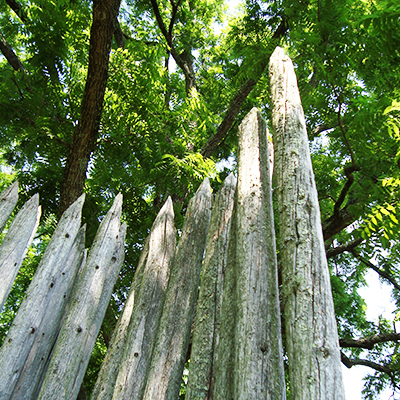The Palisade
1754 Reconstructed Village | The Palisade | The Log House | The Brewer’s House | The Potter’s House | The Gemeinhaus
 As the English and French fought against one another for control of the North American continent, they enlisted Native American allies to help in their attacks. The Moravians were not immune to the fighting, and as stories of families attacked by Native Americans reached Bethabara, the Brethren decided to build a palisade around the village houses, “making them safe before the first incursion of the Indians should take place.”
As the English and French fought against one another for control of the North American continent, they enlisted Native American allies to help in their attacks. The Moravians were not immune to the fighting, and as stories of families attacked by Native Americans reached Bethabara, the Brethren decided to build a palisade around the village houses, “making them safe before the first incursion of the Indians should take place.”
A stockade was erected in 1756 to protect inhabitants and non-Moravians who came for shelter from attack by Native Americans throughout the French & Indian War. Built with the unskilled labor of the Moravians and their neighbors, the original palisade fort was constructed in 18 days. The pales were crooked oak, pine and cedar logs of various sizes, available from timber felled on the hillside above the town that had been cleared for defense against attack. The fort had no bastions, a detail that reflected the Brethren’s lack of military skill and the speed with which the stockade was constructed. Created in haste in response to reports of local attacks, the Moravians had only enough time to create a rough wall that would separate the settlers from hostile Shawnees. The initial construction indicates that its purpose was to stop the rush of a foe that preferred close combat with a tomahawk rather than musket balls.
The fort was strengthened in 1758 as the Cherokee War heated up and a multitude of non-Moravians began fleeing to Bethabara for protection. It was reinforced yet again in 1760 as the war intensified. It is essentially this last 1760 configuration that is represented in the reconstructed fort today. The palisade fort lasted 8 years. In 1763 peace was confirmed and the fort was taken down.
The fort is the only French & Indian War fort in the southeast reconstructed on its original site. South Carolina State Archeologist Stanley South, the pre-eminent expert on historic archeology of early fortifications, researched, excavated and reconstructed the Bethabara palisade fort in the 1960s and recovered the remains of the first fort during his archeological excavations. The reconstruction of the fort followed the pattern of the palisades discovered during his excavations.
In 2012 the Historic Bethabara Park Inc. Trustees, concerned about degenerating fort posts and fallen palisades, elected to replace the Palisade Fort. Deterioration at the base had caused individual palisades to fall, raising safety issues. Reconstruction took place between November 2012 and January 2013. Wilson-Covington Construction Co. replaced the 2200 fort posts and re-graded the area surrounding the palisades to allow for water run-off to insure long term preservation. The top of each post was individually sharpened and posts were hand worked with a draw knife to create a hand hewn appearance.
This significant reconstruction project was recognized with two prestigious awards: the Preservation North Carolina 2013 Minnette C. Duffy Landscape Preservation Award and Preserve Historic Forsyth’s 2013 Cultural Landscape Award.
The 1756 Palisade Fort, the only French and Indian War fort reconstructed on its original site, based upon archaeology and historic maps.
The 1752 Wagner cabin, based upon historic map, drawings, and archaeology.
The 1754 first settlement village, including four buildings, an oven, and fencing, based upon historic maps, drawing, and archaeology.
The 1765 Calf Barn, with original 18th Century timber-frame and implement exhibits.
The 1754 Single Brothers House, which was soon used as a horse stable.
1758 Grape Arbor, the earliest known example in the Carolina Piedmont Backcountry.
